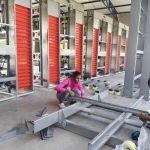In the rapidly evolving world of poultry farming, choosing the right equipment is crucial for maximizing efficiency and productivity. As we look towards 2025, one of the most significant considerations for poultry farmers is selecting the best layer battery cage system. These systems have revolutionized egg production, offering numerous benefits such as space optimization, enhanced bird welfare, and increased productivity. This article explores the best layer battery cage options for your poultry farm in 2025, providing insights into features, benefits, and future trends.

Understanding Layer Battery Cages
Layer battery cages are a popular chicken housing system for egg-laying hens, designed to optimize space and enhance egg production. The name “battery” comes from the arrangement of cages in rows and columns, similar to an artillery battery. These systems have been subject to debate regarding animal welfare, but their advantages in terms of efficiency and productivity cannot be overlooked.
Key Features of Layer Battery Cages
- Space Optimization: Battery cages are designed to maximize space utilization, allowing farmers to house a large number of hens in a compact area. This is particularly beneficial for farms with limited land.
- Tiered Design: Many battery cage systems employ a tiered layout, utilizing vertical space to accommodate more layers. This design facilitates better management and easy access to birds on different levels.
- Feeding and Watering Efficiency: These systems incorporate efficient feeding and watering mechanisms, ensuring each layer has easy access to a balanced diet and proper hydration, which is crucial for optimum egg production.
- Manure Management: Battery cages are equipped with efficient manure collection systems, simplifying waste removal and maintaining cleanliness in the poultry house.

Benefits of Layer Battery Cages
- Increased Egg Production: Battery cages allow for efficient monitoring and management of each bird, optimizing conditions for higher egg production.
- Improved Bird Health: The design minimizes the risk of disease transmission and ensures a hygienic environment, enhancing overall bird welfare.
- Cost Efficiency: With reduced feed wastage and efficient space utilization, battery cages offer significant cost savings for farmers.
Choosing the Right Battery Cage System
When selecting a battery cage system for your poultry farm, several factors must be considered:
1. Cage Design and Material
- A-Frame vs. H-Frame Battery Chicken Cages : A-frame cages are typically 3-4 tiers high, offering a compact solution, while H-frame cages can have up to 8 tiers, providing flexibility for housing more birds.
- Material Quality: Opt for cages made from durable materials like galvanized steel to ensure longevity and minimal maintenance.
2. Automation and Technology
Investing in automated systems for feeding, watering, and egg collection can significantly enhance efficiency and reduce labor costs. Look for systems that integrate smart technology for data monitoring and management.
3. Bird Welfare Considerations
Ensure the cage design provides adequate space for natural behaviors such as perching and dust bathing. Prioritize systems that offer good ventilation and lighting to maintain bird health.
4. Cost and Budget
Evaluate the cost-effectiveness of different systems by considering both initial investment and long-term benefits. A higher upfront cost may be justified by increased productivity and reduced operational expenses.

Future Trends in Layer Battery Cages
As we move towards 2025, several trends are shaping the future of layer battery cages:
- Alternative Housing Systems: Growing concerns about animal welfare are driving interest in enriched cages, aviaries, and free-range systems that offer more freedom for hens.
- Smart Farming Technologies: Automation and data analytics are becoming integral to modern poultry farming, enabling precise management and optimization of resources.
- Sustainability and Health: There is a heightened focus on sustainable practices and proactive health management, including biosecurity measures and genetic selection for disease resistance.
Conclusion
Selecting the best layer battery cage for your poultry farm in 2025 involves careful consideration of design, technology, and animal welfare. By investing in a high-quality battery cage system, you can enhance productivity, improve bird health, and achieve significant cost savings. Stay informed about future trends and innovations in poultry farming to ensure your operations remain competitive and sustainable. For more insights and expert advice, explore our related articles and resources.





